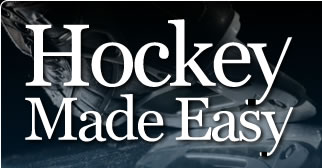Hockey is
a fantastic sport but in order to play it safely and
enjoy the experience you must
have good but not necessarily
new, or expensive, protective hockey equipment.
All the
necessary pieces must fit properly to protect your
body yet still allows for a full range of motion to
perform the required physical skills of hockey.
New or Used Equipment - buy either, as long as it
provides good protection to prevent injuries.
Used equipment can be just as protective as new
equipment and is much, much cheaper.
Protective Equipment young players will require in
order to play hockey safely:
Shin pads - protect your shins and knee caps and
extend downward to the top of your skates.
They come in different lengths so make sure they are
not too long, or too short, but just right.
Hockey Pants - protect your thighs, kidneys,
tailbone and hip area. They should be 4 to 6 inches
larger than your waist size to provide extra room
for bending and feeling unrestricted while skating.
Shoulder pads - are designed to protect your
shoulders, collar bone, rib cage, upper back,
biceps,
triceps and chest, yet provide a full range of
motion for shooting.
They are secured in place by Velcro straps and come
in different sizes, shapes and weights.
There are different designed models for forwards and
defensemen’s protection.
Elbow pads - protect your elbows and forearm and the
area between the shoulder pads
and the top cuff of your hockey gloves.
They also come in different sizes so make sure they
fit and have some flexibility and a 180 degree range
of motion for passing, receiving and shooting.
Hockey gloves - protect your hands, fingers and
wrists. They come in different cuff lengths
and widths and the palms and fingers should be thin
and flexible to grip your stick.
Try them on before buying to make sure both gloves
feel just right.
Jock or Jill strap and cup – worn to protect your
groin area and come in different waist sizes.
Garter belt – worn around your waist to hold up your
hockey socks.
Neck guard/Throat protector – worn around your neck
to prevent cuts from possible skate blades,
sticks and flying pucks.
All these pieces of protective equipment that can be
purchased second hand from some Sports Shops
like “Play it Again Sports” or at your annual Youth
Hockey Equipment sale at the start of the season.
This helps to keep the high costs of playing hockey
down.
Hockey Helmet with Visor or Cage
- I do recommend purchasing a new helmet and a full
plastic visor
or full wire cage because a used helmet could be
damaged with very fine cracks that you cannot see
and it is not worth taking a chance of getting an
injury to your head or face.
It must fit properly not moving around.
However having said that, all equipment purchased
must fit properly so it doesn’t move or shift if
your child happens to fall.
Proper fitting equipment will cushion the fall
providing there is no space between the specific
pieces of equipment and it is strapped in place
correctly.
Cracked pieces of equipment can be made safe by
using duct tape to hold the crack in place.
If purchasing new equipment the Sports stores
salesperson should be able to help you get the
correct size.
Underwear - light cotton, or the new breathable
material, long john type, top and bottom underwear
should be worn under your equipment. Keep it clean
and odour free.
After the Game - take your equipment out of your
hockey bag and let it air out to dry.
Skates should not be placed around direct heat as
they could crack the plastic blade holders.
Just let them air dry also.
Hockey Bag - a hockey bag must be large enough to
carry all of your equipment. It should have 2 or 3
large outside pockets to carry your skates and for
dry and your wet underwear after the game.
Keep an extra pair of skate laces, proper length in
your bag for emergency and a small towel to dry your
skate blades, rivets and blade holders after the
game or practice to prevent them from rusting or
cracking.
The newer hockey bags come with 2 wheels and a
handle, like a suitcase for easier handling.
The old ones with handles are fine also.
Have a great hockey season.
John Shorey
Author- “Hockey Made Easy”
jshorey@hockeymadeeasy.com





